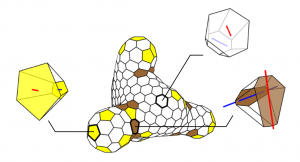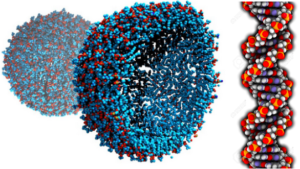 The biophysics group works on a range of problems at the level of molecules, viruses, cells, tissues, and organisms, complementing the biophysical topics by those in soft condensed matter physics. Very important aspects of the program are the modeling and development of minimal models of structures and processes such as epithelial tissues. The research is embedded in global science, which is reflected in joint publications with partners from abroad and in the participation in bilateral collaborations and international networks, organization of scientific meetings, and student exchange. The biophysics group works on a range of problems at the level of molecules, viruses, cells, tissues, and organisms, complementing the biophysical topics by those in soft condensed matter physics. Very important aspects of the program are the modeling and development of minimal models of structures and processes such as epithelial tissues. The research is embedded in global science, which is reflected in joint publications with partners from abroad and in the participation in bilateral collaborations and international networks, organization of scientific meetings, and student exchange. |
People
- Urška Andrenšek
- Anže Rapoš Božič (homepage)
- Veronika Bukina
- Mojca Čepič (homepage)
- Matej Kanduč (homepage)
- Katarina Kokalj
- Matej Krajnc (homepage)
- Tanmoy Sarkar
- Fabio Staniscia
- Marin Šako
- Domen Vaupotič
- Nataša Vaupotič
- Primož Ziherl (head; homepage)
- Urban Železnik
SHAPE AND STRUCTURE OF EPITHELIAL TISSUES AND LIPID VESICLESWe explore mechanical models of single-cell-thick epithelial tissues, focusing on the role of tissue fluidization, apico-basal differential tension, etc. on the shape of tissue. At a more synthetic level, related effects are studied in the context of shape, self-replication, and aggregation of lipid vesicles. PeopleMatej Krajnc, Jan Rozman, Primož Ziherl Selected publications
|
|
VISCOELASTICITY AND ACTIVE DYNAMICS OF CELL-CELL JUNCTIONSWe develop theoretical models of the viscoelasticity and active dynamics of cell-cell interfaces so as to better understand the active in-plane cell rearrangements during morphogenesis and tissue repair. We study how active forces, generated at the cell-cortex level, drive cell-junction remodeling and how these dynamics are affected by the collective cell mechanics. PeopleMatej Krajnc, Clement Zankoc Selected publications
|
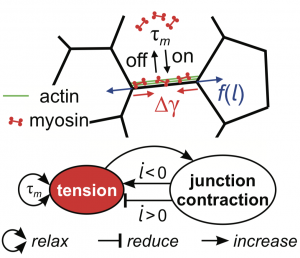 |
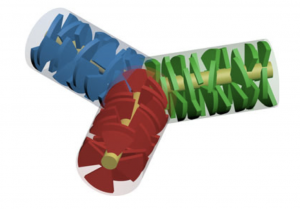
|
CONTACT INTERACTION IN SOFT COLLOIDS, QUASICRYSTALS, HYPERUNIFORMITY, AND NOVEL LIQUID-CRYSTALLINE MATERIALSOur soft-condenses matter projects address the micromechanical rationale of the stability of non-close-packed crystals formed by soft nanoparticles, starting from the hypothesis that the structure of these crystals is determined by the elastic deformation of the particles upon contact. We also work on novel 2D quasicrystals in model monodisperse particles with isotropic interaction, which include structures with exotic and non-forbidden rotational symmetries. Another topic studied is systems of particles confined to a sphere, where we employ a suitably generalized notion of hyperuniformity to investigate the type of order and ordering transitions. Within the liquid-crystalline domain, our present focus is one, two, and three-dimensional mesophases formed by achiral molecules. PeopleAnže Božič, Mojca Čepič, Nataša Vaupotič, Primož Ziherl Selected publications
|
PHYSICAL VIROLOGYWe explore different aspects of the physics of viruses, focusing on the role of electrostatic interactions in various guises—screened interactions, strong coupling, and charge regulation mechanisms—for the stability and assembly of simple spherical capsids. We also study the physical constraints acting on the single-stranded RNA genomes that pack into capsids and how these determine their permitted mutations. PeopleAnže Božič, Horacio V. Guzman, Matej Kanduč Selected publications
|
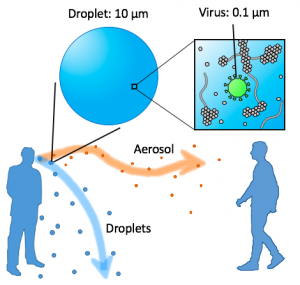 |
|
CELL-LEVEL SIMULATIONS
We develop vertex models of epithelial tissues, focusing, e.g., on the implementation of processes leading to tissue fluidization.
People |
|
MOLECULAR SIMULATIONS
Our group uses molecular dynamics simulation techniques combined with analytical modeling to investigate biological and other soft-matter systems on the nanoscale. The current research projects include the investigation of biopolymers (RNA) and hydrogels, lipid membranes, and wetting phenomena. PeopleSelected publications
|
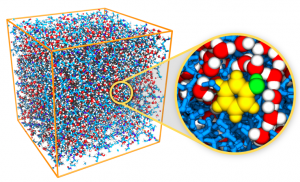 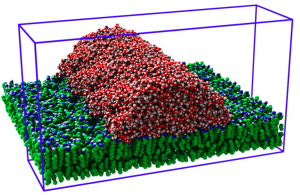 |


